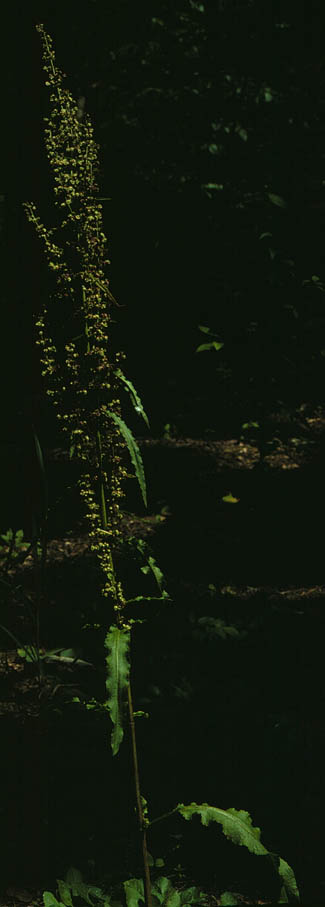 |
 |
 |
- Curly Dock
- Curled Dock
- Yellow Dock
- Sour Dock
- Narrow Dock
- Bladder Dock
- Class: Magnoliopsida
- Order: Polygonales
- Family: Polygonaceae
- Subfamily: Rumicoideae
- Tribe: Rumiceae
- Genus: Rumex
Rumex crispus |
||
| AREA | STATUS | REFERENCES |
| North America:
Continental United States; Canada |
Yes | Frankton, 1956 and U.S. Dept. of Agriculture, 1970 |
| Eastern North America:
United States east of Mississippi; Ontario and eastern Canada |
Yes | Frankton, 1956 and U.S. Dept. of Agriculture, 1970 |
| Southeastern United States:
AL AR DE DC FL GA KY MD NC SC TN VA WV |
Yes | U.S. Dept. of Agriculture, 1970 |
| Southern Appalachian States:
AL GA KY MD NC SC TN VA WV |
Yes | U.S. Dept. of Agriculture, 1970 |
| Coastal Plain | Yes | U.S. Dept. of Agriculture, 1970 |
| Piedmont | Yes | U.S. Dept. of Agriculture, 1970 |
| Blue Ridge Mountains | Yes | U.S. Dept. of Agriculture, 1970 |
| Great Smoky Mountains National Park | Yes | U.S. Dept. of Agriculture, 1970 |
| Ridge and Valley | Yes | U.S. Dept. of Agriculture, 1970 |
| Cumberland Plateau | Yes | U.S. Dept. of Agriculture, 1970 |
| Georgia | Yes | U.S. Dept. of Agriculture, 1970 |
| Clarke County, Georgia | Yes | personal observation |
Habitat and Diet. Rumex crispus is a common perennial that is from Eurasia and is now found throughout the United States and Canada. It grows best in nutrient-rich, sandy and moist soil. For prime germination conditions, light and/or alternating temperatures are best. Ethylene gas has been found to increase germination in the light. (Click here for more info on germination)
Life Cycle and Seasonal Activity. R. crispus reproduces by seed. These seeds germinate in early spring, late summer, or fall. The cotyledon blades of the seedling are oblong, taper at the base and are dull green and fleshy. The plant may stay in its seedling stage over the winter. As the plant matures, it produces a fruit constricted by two seeds. One plant may produce up to 160 seeds. At maturity, the plant can grow up to 1.5 meters and the entire plant turns reddish-brown. R. crispus flowers between June and September.

Datta, Subhash Chandra. A Handbook of Systemic Botany Asia Publishing House, NY. (1970). 562 pages.
Frankton, Clarence. Weeds of Canada Queens Printer and Controller of Stationary. (1956). 169 pages.
Jackson, Daydon and Joseph D. Hooker. Index Kewensis. vol. 2 The Claredon Press, Oxford. (1895). 1299 pages.
Linnaeus, Carolus. Species Plantarum vol 3. (1753).
Maot, Emm Le and J. Decaisne. A General System of Botany Longmans, Green, Reader and Dyer Paternoster Row. (1873). 305 pages.
Snogerup, Sven. "Rumex Subgenus Rumex in the Flora Nordic Area." In Svensk Botanisk Tidskrift. vol. 85 no. 4 (1991). P 249-260.
United States Department of Agriculture. Selected Weeds of the United States. United States Government Printing Office (1970). 463 pages.